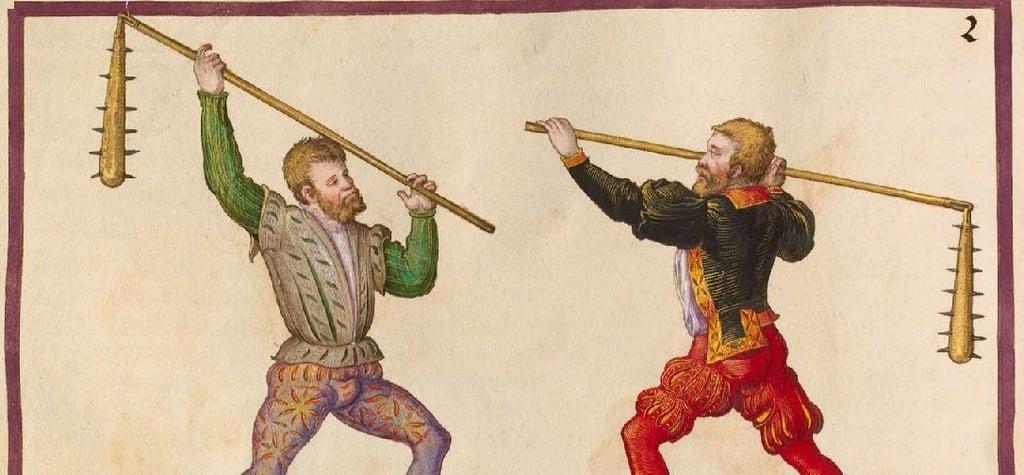The Flail: A forgotten weapon of d&d 5e
The flail often goes unused since it is objectively less effective than other weapons. Let's see if we can improve it.
Nikos Konstans
4/15/20243 min read


The Flail
When it comes to medieval weapons, the flail is often portrayed as a fearsome and deadly weapon. In the world of Dungeons & Dragons 5th edition (5e), however, the flail seems to have lost its luster. In this blog post, we will examine the historical background of the flail, its uses, and why it is considered obsolete in comparison to other weapons like the longsword, battleaxe, or warhammer. Additionally, we will explore potential ways to improve the flail for the 5e system, including the design of a new flail feat.
Historical Background and Uses of the Flail
The flail is a weapon that dates back to the medieval era. It consists of a spiked metal ball attached to a handle by a chain or rope. The primary purpose of the flail was to deliver powerful strikes that could penetrate armor. It was particularly effective against opponents wearing plate armor, as the spikes could pierce through the gaps.
In historical contexts, the flail was primarily used by foot soldiers and knights. It offered them a versatile weapon that could be used to strike from a distance or in close combat. The swinging motion of the flail allowed for unpredictable attacks, making it difficult for opponents to block or parry. The flail served as an excellent counter to those who wield shields.
The Obsolescence of the Flail in D&D 5e
In the world of D&D 5e, the flail has become overshadowed by other weapons like the longsword, battleaxe, or warhammer. There are several reasons why the flail is considered obsolete:
Limited Damage Potential: In 5e, the flail deals 1d8 damage, which is the same as a longsword, battleaxe, or warhammer. However, the flail lacks the versatile property, making it less appealing in terms of damage output.
Lack of Special Features: Many other weapons in 5e come with special features or bonuses. For example, the longsword can be used with the Great Weapon Fighting style, the rapier has the finesse property. The flail, on the other hand, lacks any unique features that would make it stand out. It simply deals 1d8 bludgeoning damage.
Due to these factors, players often overlook the flail in favor of other weapons that offer more damage potential, versatility, or special features.
Improving the Flail for D&D 5e
While the flail may currently be considered obsolete in 5e, there are ways to improve its effectiveness and make it a more appealing choice for players. Here are some suggestions:
Increase Damage Potential: One way to make the flail more competitive is to increase its damage potential. This could be achieved by increasing the damage dice to 1d10 or even 1d12, reflecting the weapon's historical reputation as a devastating armor-piercing weapon. If the die size increases, consider adding the two-handed property to the weapon. While this means it would not be useable with a shield, this would open up its use for features like Great Weapon Fighting, or the feat Great Weapon Master.
Introduce Versatile Options: To enhance the versatility of the flail, it could be given the versatile property, allowing players to wield it with one or two hands. This would give them the option to increase their damage output or have a free hand for other actions. Adding the Versatile feature would put it on par with the longsword.
Make it a reach weapon: Adding the reach property to the flail would open up a whole new avenue for character builds. A one-handed reach weapon would allow a character who wants to specialize in Polearm Mastery to still gain the benefits of a shield or even another weapon if they have the Dual Wielder Feat. If the reach property is added, consider reducing the damage die to 1d6 to keep the weapon balanced. Leaving the damage alone is not game-breaking, but it would make the flail significantly better.
By implementing these improvements, the flail could become a more viable and attractive choice for players in D&D 5e.
Designing a Flail Feat
As mentioned earlier, introducing a flail feat could be a great way to enhance the effectiveness of the weapon. Here is a potential design for a flail feat:
Flail Prodigy:
- You gain proficiency with the flail if you don't already have it.
- When you hit a creature with a flail, you can use a bonus action to make a follow-up attack against the same target. If you hit with this follow-up attack, you do not add your strength modifier to the weapon's damage.
- When you score a critical hit with a flail, you can choose to knock the target prone or push it 10 feet away from you.
This feat would give players using a flail the ability to chain together powerful strikes and potentially knock down or push away their opponents, adding a unique tactical advantage to the weapon.
Finally...
The flail, a weapon with a rich historical background, has unfortunately become obsolete in D&D 5e due to its limited damage potential, lack of versatility, and absence of special features. However, by implementing improvements such as increasing damage potential, introducing versatile options, and adding special features like the suggested flail feat, the flail could regain its status as a formidable weapon choice in the 5e system. So, next time you're creating a character, consider giving the flail a chance!
Contacts
rollthemtomes@gmail.com
